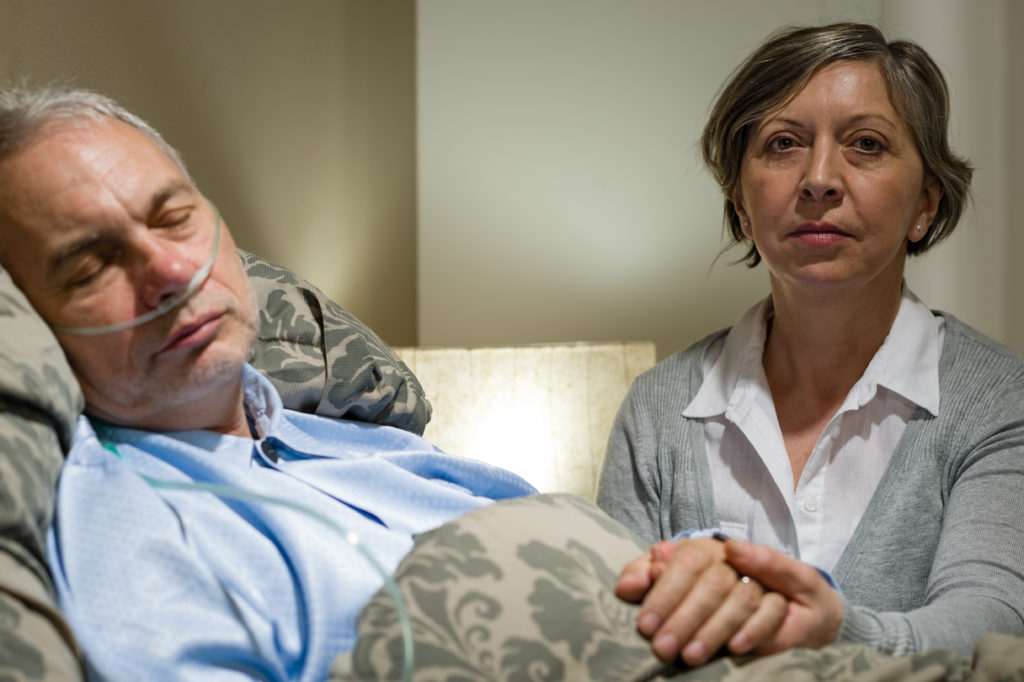“Are you covering Mr. R?” the nurse on the phone asked me.
“Yes, I’m covering that patient this evening.”
“I think he may have died,” she said nervously.
“Okay, I’ll be right there.”
Start your day with Public Discourse
Sign up and get our daily essays sent straight to your inbox.I hurried out of the physician workroom and took the elevator down seven floors to see Mr. R. He was a patient with metastatic colon cancer invading nearly every organ in his body. Multiple rounds of chemotherapy had failed. His cancer was resistant to every known treatment. After a long course, he had come to terms with his impending death and agreed to hospice care.
The idea of hospice, or end-of-life, care is fairly novel. In the 1960s and 1970s, Florence S. Wald, the late Yale University nursing school dean, created a medical team that founded the first US hospice in Branford, CT. She was inspired after witnessing how patients with terminal illnesses were treated in a London hospice center. Hospice provides comfort to those who imminently face the end: it is meant to add life to the remaining days, weeks, or months. Nurses and physicians seek only to mitigate the patient’s symptoms in a calming environment.
Mr. R, like most other hospice patients, had signed a Do Not Rescucitate (DNR) order, a legal document forbidding doctors from performing CPR, or chest compressions, on him should his heart stop. To do CPR on this patient would be futile—his life was going to end soon no matter what measures were taken. (I’ve written separately about doing CPR on my blog for The New Atlantis here and here.) He wanted to go peacefully; he wanted us to let him be; he wanted to die, as some phrase it, with dignity.
Death Is Not Dignified
I opened the door to his hospital room and the nurse and I walked in. The patient had clearly passed away. His head was turned toward the door, motionless. His eyes stared at us as we walked in. His mouth stood agape as if about to project some sound, but only silence emerged. There was no sweat glistening on his forehead, no tossing and turning, and no voice to be heard. He simply lay there as still, silent, and cold as a glacier.
I listened to his heart and lungs with the stethoscope. I felt for a pulse at his wrist. I tested for a gag reflex, crudely sticking a wooden tongue depressor all the way to the back of the patient’s throat. But nothing happened and I heard nothing. Two to three flies already congregated around the victim, taunting him, daring him to shoo them away. He didn’t move as they encircled his head, a kind of perverse halo.
“Time of death,” I said to the nurse, “2:33 am.”
The tragic scene did not end in the hospital room. My hands shaking nervously—this was the first time I had ever pronounced a patient dead—I called his wife. She knew immediately. “He’s died?” she asked. “Yes,” I replied, “I am so sorry.” She burst into tears. She had prepared herself for this moment, only to break down when it finally came. “I’ll be there as soon as I can,” she said in between sobs before she hung up.
It has become common to talk of “death with dignity” in the policy world. There’s a Death with Dignity Act in Oregon, which permits physician-assisted suicide. There’s a Death with Dignity Act in Washington, which also legalizes physician-assisted suicide in certain circumstances. A Death with Dignity National Center exists in Portland, OR, a nonprofit that advocates for patients to “make their own end-of-life decisions, including how they die”—its website is plastered with images of smiling faces. The message, it seems, is that if one can control how one dies or when, the dying process is somehow less disturbing, awful, and humiliating. Instead, it can be dignifying.
Conversely, when dealing with end-stage cancer patients and palliative-care physicians in the hospital I rarely hear the “death with dignity” phrase used; more often I hear a palliative-care doctor say, “we want him (or her) to be comfortable.” It is a marked difference between the palliative-care movement and the assisted-suicide movement. In hospice, there is a resignation to the uneasiness and difficulty that comes with any death. With palliation, nurses and doctors can only free the patient from pain but not from the indignity of dying.
Indeed, the concept of “death with dignity” is a euphemism for what is one of the most heart-wrenching, difficult, unsettling, and undignified events of human existence. I think of that patient who chose to make his death comfortable and the image is disturbing rather than heartening. Where is the dignity in lying in a bed with flies buzzing around one’s head, vulnerable and lifeless?
Dignity in Caring for the Dying
In a 1974 article titled The Indignity of ‘Death With Dignity’ in Hastings Center Studies, Paul Ramsey, the late Princeton professor and ethicist, reflects on the idea of death with dignity. Ramsey argues,
There is nobility and dignity in caring for the dying, but not in dying itself. . . . It is more correct to say that a therapist brings to the event, from some other source, an awareness of the uniqueness, the once-for-allness of an individual life-span as part of an ‘outlook’ and ‘on-look’ upon the vast sea of humanity. In any case, that is the reflected glory and dignity of caring for the dying, that we are or become aware of the unique life here ending. The humanity of such human caring is apt to be more sensitive and mature if we do not lightly suppose that it is an easy thing to convey dignity to the dying.
Death is not simply a part of life but the end of human life—the end, in some sense, of an entire world. It is the transformation of a living member of our species into an immobile mass of flesh with no potential for life again. Rabbinic Jewish authorities recognized this in the Mishnah, an extensive commentary on Jewish law, when they wrote, “anyone who destroys a life is considered by Scripture to have destroyed an entire world; and anyone who saves a life is as if he saved an entire world.” Thus, not only are the physical manifestations of death ignoble and viscerally disturbing but, in principle, the end of an individual is tragic, too.
As Ramsey explains, this is brought into sharp relief by the role of the caretaker. Those who care for the dying will be better providers if they are empathetic, that is, if they realize that the burden of dying is inherently difficult, and help to bear part of that burden. The job of the caretaker would be easy if choosing when one passed made the process noble. This was evident when I told the patient’s wife that her husband had passed away. She already knew and accepted that her loved one was dying. She had met with the medical team. She and her husband discussed this with the rest of the family and agreed that he would merely receive symptomatic treatment and comfort care from the family, nurses, and physicians. But the pain of her loss and her husband’s death remained.
Death and dying detract from life by ending it. There are more or less disturbing ways to pass (you can die while someone is breaking your ribs doing CPR or you can die without that), but none of them is truly dignified. And choosing to preempt death using physician-assisted suicide doesn’t change this. In truth, there is no such thing as death with dignity. There is only somber tragedy, as your body lies exposed to the world’s Hobbesian bacteria and insects.
What Gives Death Dignity
Consequently, if we want our loved ones to retain dignity in death we ought to look at the lives they lived. The people we have chosen to become and the ways in which we have chosen to spend our lives are the only things that matter at the end. As the late Dr. Sherwin Nuland, a surgeon and author at Yale, wrote in his book How We Die: “The greatest dignity to be found in death is the dignity of the life that preceded it. This is a form of hope we can all achieve, and it is the most abiding of all. Hope resides in the meaning of what our lives have been.”














